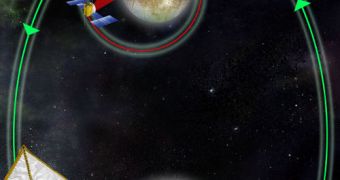Astronomers are now proposing that solar sail spacecrafts be used for the upcoming exploration missions to the moons of Saturn and Jupiter.
The experts say that these so-called data clippers could play a very important role in future missions, because they could potentially carry vast amounts of information from one point of the solar system to another.
This could prove to be very effective for easing some of the load placed on orbiters and landers going to other planets, that at this time need to spend a lot of energy to contact Earth.
Conceivably, the solar sails would act like shuttles, constantly moving between our planet and the one being explored. The technology is now available, and could be developed to the necessary requirements within just a few years.
Envisioned by Thales Alenia Space expert Joel Poncy, the solar sail system would contain several spacecraft, so as to ensure a rather seamless flow of data from distant orbiters and explorations robots.
Free of the burden of having to contact Earth, the machines could then focus more on their mission objectives, producing more invaluable scientific data, and sending it back aboard a data clipper.
“Space-rated flash memories will soon be able to store the huge quantities of data needed for the global mapping of planetary bodies in high resolution,” Poncy argues, quoted by Universe Today.
“But a full high-res map of, say, Europa or Titan, would take several decades to download from a traditional orbiter, even using very large antennae,” he goes on to say.
“Downloading data is the major design driver for interplanetary missions. We think that data clippers would be a very efficient way of overcoming this bottleneck,” the expert argues.
According to an analysis made by Poncy and his team, constructing such networks of data clippers is entirely feasible and possible, and also achievable within the next two decades.
“We have looked at the challenges of a data clipper mission and we think that it could be ready for a launch in the late 2020s,” the satellite expert says.
“This means that the technology should be included now in the roadmap for future missions,” he adds. This line of thought was prompted by the success of the Japanese Ikaros solar sail demonstrator.
In space for only a few month, the spacecraft has already shown that it can move propelled by photons released from the Sun, and also that it can steer at will.
“Using the Sun as a propulsion source has the considerable advantage of requiring no propellant on board. As long as the hardware doesn’t age too much and the spacecraft is maneuverable, the duration of the mission can be very long.” Poncy concludes.

 14 DAY TRIAL //
14 DAY TRIAL //